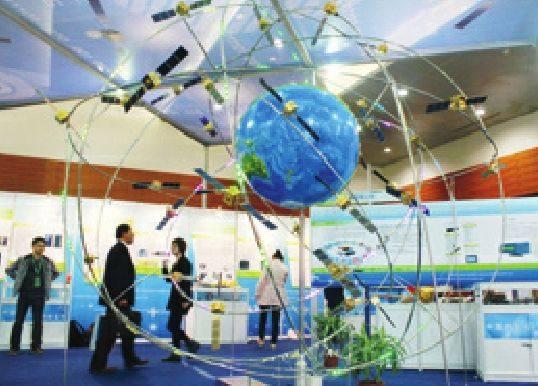The Satellite Life
2012-04-29ByTangYuankai
By Tang Yuankai

Despite his ripe age of 83, Sun Jiadong, a renowned scientist in Chinas aerospace field, is still as busy as ever. In mid-November, Sun flew to Shenzhen, south Chinas Guangdong Province, to attend the China Hi-tech Fair as the chief designer of the Beidou Navigation Satellite System, also known as COMPASS.
In the exhibition hall, Beidou attracts a throng of visitors. Recently, the 16th Beidou satellite was launched into space by a Long March rocket on October 25, marking another major achievement in the development of Chinas own navigation satellite network covering the Asia-Pacific region.
China has launched four experimental satellites and 16 navigation satellites in space so far. The Beidou system has been in service in China for five years and it will start to provide positioning services for the whole AsiaPacific region next year.
Guiding star
Sun, a member of the Chinese Academy of Sciences, is wildly proud of Beidou, which is the third positioning system put into service, following the Global Positioning System (GPS) (the United States) and Global Navigation Staellite System (GLONASS)(Russia). The European Union also is developing its positioning system called Galileo.
“China is a rising power of aerospace science and technology. The country was able to establish its own independent satellite navigation system,” said Sun.
In the 1980s, China created a three-step strategy for its Beidou satellite navigation project, said Sun. During step one from 2000 to 2007, four Beidou-1 satellites were launched into geostationary orbit for experimentation. In step two, China is to establish a navigation and positioning network consisting of 16 Beidou-2 satellites for the Asia-Pacific region by the end of 2012. And in step three, a global network would be made up of 35 Beidou satellites by 2020.
“The project is now two-thirds complete,”said Sun.
Compared to other satellite navigation systems, Beidou has its own unique features. Unlike GPS, which only relays signals, Beidou users are able to send messages to the system directly through their devices. Terminals can communicate with each other as easily as using a cellphone or fax machine.
The Beidou system was put to tremendous and life-saving use during the catastrophic Wenchuan Earthquake in May 2008. The earthquake damaged most of the ground communication facilities, leaving communication between disaster-hit areas and the outside completely interrupted.
Rescuers thus went to disaster-hit areas carrying Beidou terminals and were able to send information to the rescue headquarters quickly.
The second generation of Beidou has been significantly improved. Its message function even extends to microblogging websites. If a user sends a message to the cellphone of a microblog user, the system will automatically update the message on the microblog. The message function is very important for those who are traveling in remote areas or on the ocean. If their cellphone isnt functioning, they can maintain contact through Beidou.
Moreover, Beidou is backwards compatible: Users can shift to GPS easily.
“Along with the advances in technology, Beidou will be put into broader use over the next two years,” said Sun, adding that the satellite system will provide service for the Asia-Pacific region in 2013 and Shanghai will build a testing center for the satellite.
“In the near future, Beidou will be installed on vehicles such as taxis, chemical cargo trucks and armored cash carriers,” said Shen Xueming, Director of Shanghai Engineering Center for Microsatellites and the man responsible for the Beidous services in Shanghai.
People in Shanghai will be able to enjoy a more convenient and efficient public transport by using their smart phones to search for the nearest bus or even taxi. Transport infrastructure, such as bus stops, could also be equipped with Beidou use, said Shen.
“Beidou has the equivalent performance of other positioning systems like GPS in terms of some key functions. Its precision with regards to position will be further improved as the project develops,” said Sun. “In the near future, Beidou will have its uses in transportation, tourism and public services.”
The first satellite
Aside from the Beidou satellite positioning system, Sun has been a pioneer of most of Chinas satellites and space exploration projects over the past half century and has dedicated his life to Chinas aerospace industry.
“I spent seven years studying airplane design, nine years on missiles, and 40 more years on launching satellites,” he said. China created and launched over 100 satellites and spacecraft over the past four decades. One third of them were attributed to Suns work.
To this silver-haired scientist, the most memorable experience is Chinas first satellite launch in 1970.
“It is easy to launch a satellite thanks to Chinas current aerospace science and technology. But in the late 1960s, we didnt even have a 21-core plug,” recalled Sun.
At that time China was prevented from possessing high technology during the Cold War. Moreover, the “cultural revolution”(1966-76) seriously impacted the aerospace industry and most research was suspended.
Despite the major setbacks, the Chinese Government vowed to launch its first satellite by 1970. The first satellite was considered more a political success than a scientific one, an attempt for China to show the world that it had grasped satellite technology.
Qian Xuesen (1911-2009), a leading mind in rocket technology, was presiding over major aerospace projects in the middle of the last centu- ry when he appointed Sun to organize a research team to develop the countrys first satellite. With a team of 18 scientists, Sun developed the prototype Dongfanghong-1 in October 1969.
But there was a problem.
Researchers hoped that the public could see the satellite live with their own eyes.
Sun and his team tried different ways to light up the surface of the satellite in order to make it visible, but to no avail: The team realized that no matter how they lit up the satellite, it was indistinct to the naked eye.
One member of the team suggested the answer lay in the third and final stage of the rocket, upon which the satellite rested. Sun and his colleagues designed a balloon coated with aluminum and attached it to the third stage. When the satellite was launched into orbit, the rockets final stage would fly in tandem with the satellite. The balloon would be easy to spot.
But, as Sun stressed, “We had to tell people that what they saw was the balloon, and the satellite is near the balloon.”
On April 24, 1970, Chinas first satellite Dongfanghong-1 was launched into space. Thousands of people gathered at Beijings Tiananmen Square to watch as the Dongfanghong-1 flew over.
In the ensuing decades, Sun designed numerous space projects, many of which are milestones for Chinese aerospace science and technology, including moon exploration.
Today, Sun is still at it.
“What I need to do now is to cultivate more researchers and scientists for the future of Chinas aerospace development. I hope I can do that,” he said.
